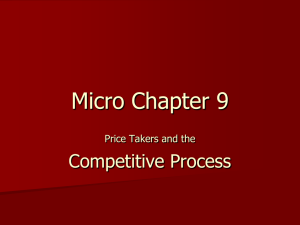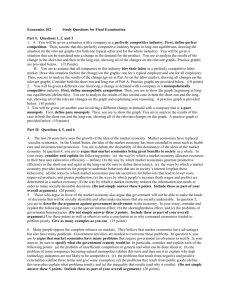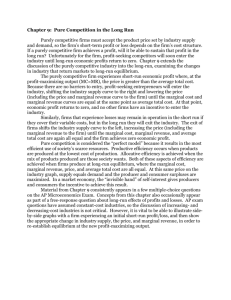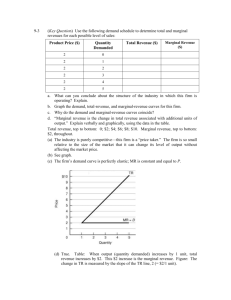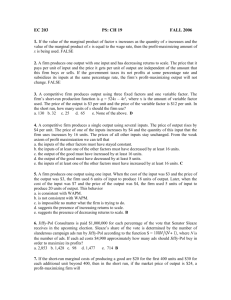Chapter 13 Review
advertisement
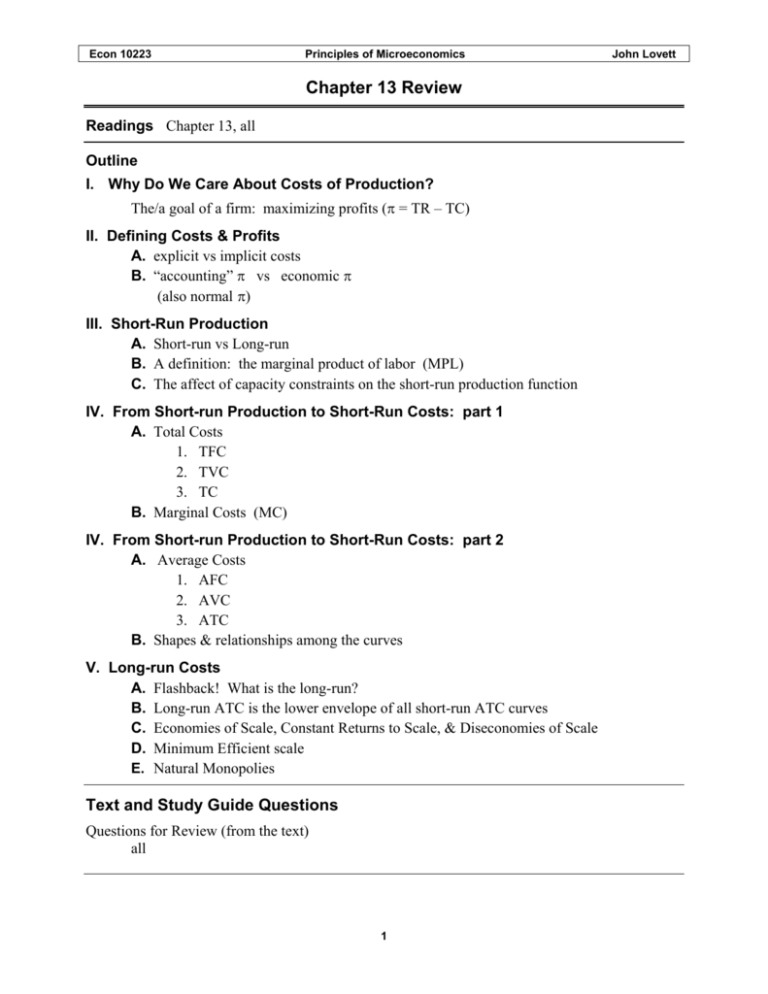
Econ 10223 Principles of Microeconomics Chapter 13 Review Readings Chapter 13, all Outline I. Why Do We Care About Costs of Production? The/a goal of a firm: maximizing profits (π = TR – TC) II. Defining Costs & Profits A. explicit vs implicit costs B. “accounting” π vs economic π (also normal π) III. Short-Run Production A. Short-run vs Long-run B. A definition: the marginal product of labor (MPL) C. The affect of capacity constraints on the short-run production function IV. From Short-run Production to Short-Run Costs: part 1 A. Total Costs 1. TFC 2. TVC 3. TC B. Marginal Costs (MC) IV. From Short-run Production to Short-Run Costs: part 2 A. Average Costs 1. AFC 2. AVC 3. ATC B. Shapes & relationships among the curves V. Long-run Costs A. Flashback! What is the long-run? B. Long-run ATC is the lower envelope of all short-run ATC curves C. Economies of Scale, Constant Returns to Scale, & Diseconomies of Scale D. Minimum Efficient scale E. Natural Monopolies Text and Study Guide Questions Questions for Review (from the text) all 1 John Lovett Econ 10223 Principles of Microeconomics John Lovett Other Problems 1. What is the definition of the short-run (in reference to production) in economics? 2. What is the definition of the long-run (in reference to production) in economics? 3. Marginal cost may initially decrease as production expands. Why would marginal cost fall during the early stages of production? 4. Marginal cost, in the short-run, will always increase as production expands beyond some point. What causes this increase in marginal cost? 5. Indicate whether the following statements are true or false regarding average fixed costs. __________ If marginal costs are greater than average fixed costs, average fixed costs are rising as production increases. __________ Average fixed costs always fall as production increases. __________ Average fixed costs may eventually fall as production increase, but will always eventually rise as production increases. __________ Marginal costs crosses AFC at AFC’s lowest point. __________ The average fixed cost curve is generally U-shaped (falling then rising). __________ AFC = ATC + AVC 6. Indicate whether the following statements are true or false regarding average total costs . __________ If marginal costs are less than average total costs, average total costs are falling as production increases. __________ Average total costs always fall as production increases. __________ Marginal costs crosses ATC at ATC’s lowest point. __________ The average total cost curve is generally U-shaped (falling then rising). 2 Econ 10223 Principles of Microeconomics John Lovett 7. Fill in blank cells in the table below for a firm manufacturing and selling wood canoes. Output Total Costs Average Costs MC per week FC VC TC AFC AVC ATC 0 0 1 $300 N.A. N.A. N.A. }___ }___ 2 $700 }___ 3 $1,200 $2,200 }___ 4 • • • • $1,800 Are these short-run or long-run costs? How can you tell? Over what range, if any, is this firm experiencing increasing returns? Over what range, if any, is this firm experiencing diminishing returns? 8. Ahhh … the weekend! It’s Friday, your exam is over, and you’re at your favorite restaurant friends. • Look around you and list two of the restaurant’s fixed costs. • Why are these fixed costs? • Now list two of the restaurant’s fixed costs. • Why are these fixed costs? 9. Ahhh … the weekend! It’s Friday, your exam is over, and you’re at your favorite restaurant friends. • Look around you and list two of the restaurant’s variable costs. • Why are these variable costs? • Now list two of the restaurant’s variable costs. • Why are these variable costs? 3 Econ 10223 Principles of Microeconomics John Lovett (Short-Run) ATC for Six Possible Plant Sizes $25 10. After successfully earning your business degree, the MyTie Company places $20 you in charge of its division manufacturing $’s neckties in Thailand. First you have to choose a factory size. MyTie $10 engineers have estimated average cost curves for six different sizes of factories $5 (at right). For each SRATC, factory size in 0 square feet is indicated. 400 200 600 800 1,000 Q 1,200 1,400 1,600 1,800 (ties/day) • Draw and label the long-run average cost curve for the manufacture of ties in Thailand. • Label the output range for which economies of scale present? • Label the output range for which constant returns to scale are present? • Label the output range for which dis-economies of scale present? • Which plant size should you choose if you are planning to produce 200 ties per day? • Which plant size should you choose if you are planning to produce 800 ties per day? • Which plant size should you choose if you are planning to produce 1,400 ties per day? Answer questions 11 - 12 based on the following information. Several years ago, Howard quit his job and started his own business repairing copy machines. He currently takes in $25,000 of revenues (TR) each month. His business writes checks or pays cash for $13,000 of costs each month. Assume this occurs every month. 11. What is Howard’s accounting profit? a. some number less than $12,000 per month b. $12,000 per month c. some number greater than $12,000 per month d. More information, namely competitor’s sales and costs, is needed to answer this. 12. What is Howard’s accounting profit? a. some number less than $12,000 per month b. $12,000 per month c. some number greater than $12,000 per month d. More information, namely competitor’s sales and costs, is needed to answer this. 4 Econ 10223 Principles of Microeconomics John Lovett Answer questions 13 - 15 based on the following information. A firm is operating at an output of 100. At this output, ATC = $62, AVC = $42, and MC = $52. 13. What is the Average Fixed Costs of the 100th unit? a. $ 1.192 b. $ 1.476 c. $ 20 d. $ 104 e. none of the above 14. What is the Average Variable Costs of the 101st unit? a. some number less than $42 b. $42 c. some number greater than $42 d. Indeterminate. Information on TVC when Q = 101 is needed. 15. What is the Average Total Costs of the 101st unit? a. some number less than $62 b. $62 c. some number greater than $62 d. Indeterminate. Information on TVC when Q = 101 is needed. 16. Dayton owns a daycare. Which of the following is the best example of one of his fixed cost? a. what he pays for diapers ($0.25 each) b. how much he values his labor (worth $18.00 per hour to him) c. how much he pays others to work for him ($11.00 per hours) d. the added stress he faces when the center is running at full capacity e. a $300 per year state licensing fee Answer questions 17 - 26 based on the following table. Tons of Output per week Total Costs TFC TVC MC TC 0 $900 1 $1,300 2 $1,600 3 $2,100 5 Average Costs AFC AVC ATC N.A. N.A. N.A. Econ 10223 Principles of Microeconomics 17. For which time period are these costs? a. The short-run b. the intermediate-run c. the long-run d. Indeterminate. Information on the nature of the firm’s inputs is needed. 18. What is the total fixed costs of the 3rd unit? a. $400 b. $500 c. $700 d. $900 e. none of the above 19. What is the total variable costs of the 3rd unit? a. $400 b. $500 c. $700 d. $900 e. none of the above 20. What is the marginal costs of increasing production from 2 to 3 units? a. $400 b. $500 c. $700 d. $900 e. none of the above 21. What is the average variable costs of the 3rd unit? a. $400 b. $500 c. $700 d. $900 e. none of the above 22. What is the average total costs of the 3rd unit? a. $400 b. $500 c. $700 d. $900 e. none of the above 23. Over which range is marginal product (of labor) increasing? a. 0 to 1 units of output only b. 0 to 2 units of output only c. over the entire range listed d. once output increases past 2 e. no listed range shows increasing marginal product (of labor) 24. Over which range is marginal product (of labor) declining? a. 0 to 1 units of output only b. 0 to 2 units of output only c. over the entire range listed d. once output increases past 2 e. no listed range shows declining marginal product (of labor) 6 John Lovett Econ 10223 Principles of Microeconomics John Lovett Answer questions 25 and 26 based on the following information. This information is for a firm, Nilan Manufacturing, which makes cooking pots. The company’s engineers have estimated different cost curves for several possible plant sizes. Plant Size 120,000 meter2 150,000 meter2 180,000 meter2 Lowest ATC $12.50 $10.00 $10.00 Output at which lowest ATC occurs 25 10,000 pans/day 14,000 pans/day 16,500 pans/day Which of the following describe costs over the range from 10,000 pans to 14,000 pans per day? a. dis-econommies of scale b. economies of scale c. parabolic scale effects d. hyperbolic scale effects e. constant returns to scale 26. Which of the following describe costs over the range from 14,000 pans to 16,500 pans per day? a. dis-econommies of scale b. economies of scale c. parabolic scale effects d. hyperbolic scale effects e. constant returns to scale Use the graphs below to answer questions 27 and 28. $ 0 $ Q $ 0 Q 0 Q $ $ 0 Q 0 Q 27. Which of the graphs (above) best illustrates a typical (short-run) average fixed costs curve? 28. Which of the graphs (above) best illustrates a typical (short-run) marginal costs curve? 7 Econ 10223 Principles of Microeconomics John Lovett Answers to Other Problems 1 The time period in which some inputs are fixed. 2. The time period in which all inputs can be varied. 3. Marginal costs may initially fall if expanding production gets easier and therefore cheaper. In other words, increasing returns (i.e. rising marginal product of labor) means it’s getting easier to produce another unit and therefore cheaper to produce another unit. This may occur in the early stages of production because, in the short-run, a business may be designed with a certain capacity in mind. Production may get more efficient as production expands towards this designed capacity. Another way of explaining why this may occur initially is that some tasks work better with a minimum number of people. 4. In the short-run, marginal costs will always eventually rise as production expands. The reason for this is that, in the short-run, business have some inputs which are fixed (ex. factory space), i.e. businesses have capacity constraints. Eventually, these fixed inputs or capacity constraints make it very difficult for the business to produce more. The business can use more and more variable inputs, but if it is way beyond its designed capacity, it won’t be able to use them efficiently. Producing an additional unit becomes increasing difficult and therefore increasingly expensive. 5. False, True, False, False, False, False (AFC & MC are unrelated, AFC is always falling, AFC = ATC – AVC) 6. True, False, True, True 7. • • • Output per week FC Total Costs VC TC 0 $1,000 0 $1,000 1 $1,000 $300 $1,300 2 $1,000 $700 3 $1,000 $1,200 $1,700 $2,200 4 $1,000 $1,800 $2,800 MC $300 $400 $500 $600 Average Costs AFC AVC ATC N.A. N.A. N.A. $1,000 $300 $1,300 $500 $350 $850 $333 $400 $733 $250 $450 $700 These are short-run costs. Why? Fixed inputs, and therefore fixed costs, occur only in the short-run. Increasing returns (i.e. increasing MPL) means producing an additional unit is getting easier and therefore cheaper. In other words, increasing returns is associated with decreasing marginal costs. There is no range over which this firm is experiencing decreasing marginal costs. Therefore, there is no range over which this firm is experiencing increasing returns. Diminishing returns (i.e. decreasing MPL) means producing an additional unit is getting more difficult and therefore costlier. In other words, diminishing returns is associated with increasing marginal costs. This firm is experiencing increasing marginal costs over its entire production range. Therefore, it is is experiencing diminishing returns over its entire production range. 8 Econ 10223 Principles of Microeconomics John Lovett 8. Fixed costs are any costs which cannot be changed in the short-run. Examples would include: rent, salaries of employees with long-term contracts, license fees, interest payments on past debt, and insurance payments. Rent, by the way, is the classic example of a fixed costs. Fixed cost might also include some of the phone and utilities, namely any flat rate “hook-up” charges, as agreed to in a long-term contract, which the firm cannot avoid paying in the short-run. Fixed costs have to be paid in the short-run even if the firm temporarily closes its doors. 9. Variable costs are any costs which can be changed in the short-run. Variable costs can be reduced to zero if the firm temporarily closes its doors Examples would include wages of employees (other than those on long-term salary contracts), and food bills (unless there was a long-term contract on this) and laundry services (unless there was a long-term contract on this). Variable cost would include most of the phone and utilities, namely any per unit charges that escalate as the electricity and phone are used more. (Short-Run) ATC for Six Possible Plant Sizes 10. After successfully earning your business degree, the MyTie Company places you in charge of its division manufacturing neckties in Thailand. First you have to choose a factory size. MyTie engineers have estimated average cost curves for six different sizes of factories (at right). For each SRATC, factory size in square feet is indicated. $25 Q $20 $’s LRAC $10 $5 ← 0 Economies of Scale 400 200 → 600 ← Constant Returns → ←Dis-economies of scale→ 800 Q • • • (ties/day) 1,000 1,200 1,400 1,600 1,800 (ties/day) Which plant size should you choose if you are planning to produce 200 ties per day? 2,000 ft2 Which plant size should you choose if you are planning to produce 800 ties per day? 6,000 ft2 Which plant size should you choose if you are planning to produce 1,400 ties per day? 10,000 ft2 11 – 28. You are on your own here. 9
